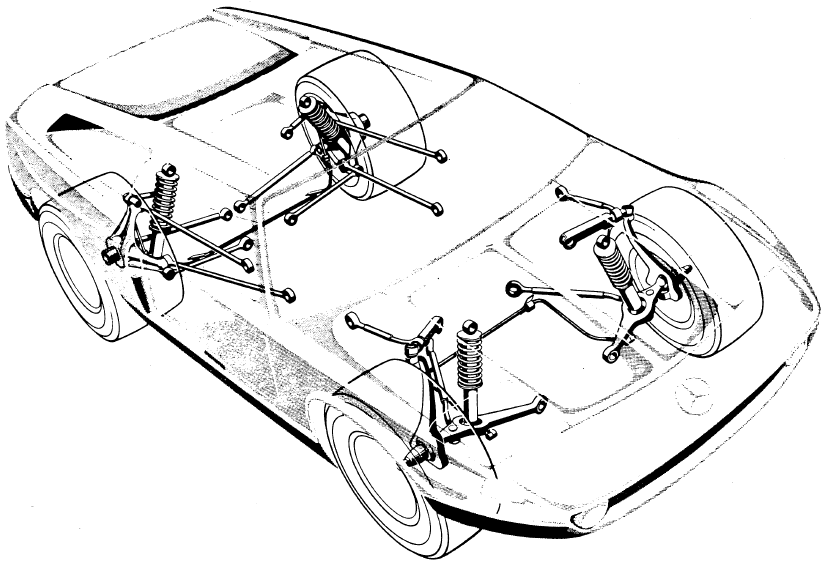Mercedes-Benz C111 on:
[Wikipedia]
[Google]
[Amazon]



 The Mercedes-Benz C111 was a series of experimental automobiles produced by
The Mercedes-Benz C111 was a series of experimental automobiles produced by
Mercedes-Benz C 111
* ttp://mercedesc111.canalblog.com/ Some information (in french) and pictures of all C111 versions {{Mercedes-Benz C111 Cars powered by Wankel engines Automobiles with gull-wing doors Sports cars

Mercedes-Benz
Mercedes-Benz (), commonly referred to as Mercedes and sometimes as Benz, is a German luxury and commercial vehicle automotive brand established in 1926. Mercedes-Benz AG (a Mercedes-Benz Group subsidiary established in 2019) is headquarte ...
in the 1960s and 1970s. The company was experimenting with new engine technologies, including Wankel engine
The Wankel engine (, ) is a type of internal combustion engine using an eccentric rotary design to convert pressure into rotating motion. It was invented by German engineer Felix Wankel, and designed by German engineer Hanns-Dieter Paschke. ...
s, diesel engine
The diesel engine, named after Rudolf Diesel, is an internal combustion engine in which ignition of the fuel is caused by the elevated temperature of the air in the cylinder due to mechanical compression; thus, the diesel engine is a so-cal ...
s, and turbocharger
In an internal combustion engine, a turbocharger (often called a turbo) is a forced induction device that is powered by the flow of exhaust gases. It uses this energy to compress the intake gas, forcing more air into the engine in order to pro ...
s, and used the basic C111 platform as a testbed. Other experimental features included multi-link rear suspension, gull-wing door
In the automotive industry, a gull-wing door, also known as a falcon-wing door or an up-door, is a car door that is hinged at the roof rather than the side, as pioneered by Mercedes-Benz 300 SL, first as a race car in 1952 ( W194), and then a ...
s and a luxurious interior with leather trim and air conditioning
Air conditioning, often abbreviated as A/C or AC, is the process of removing heat from an enclosed space to achieve a more comfortable interior environment (sometimes referred to as 'comfort cooling') and in some cases also strictly controlling ...
.
History
The first version of the C111 was completed in 1969. The car used afiberglass
Fiberglass ( American English) or fibreglass (Commonwealth English) is a common type of fiber-reinforced plastic using glass fiber. The fibers may be randomly arranged, flattened into a sheet called a chopped strand mat, or woven into glass cl ...
body shell and with a mid-mounted three-rotor direct fuel injected Wankel engine
The Wankel engine (, ) is a type of internal combustion engine using an eccentric rotary design to convert pressure into rotating motion. It was invented by German engineer Felix Wankel, and designed by German engineer Hanns-Dieter Paschke. ...
(code named M950F). The next C111 appeared in 1970. It used a four-rotor engine producing 257 kW (350 hp). The car reportedly could reach a speed of .
The company decided not to adopt the Wankel engine and turned to diesel
Diesel may refer to:
* Diesel engine, an internal combustion engine where ignition is caused by compression
* Diesel fuel, a liquid fuel used in diesel engines
* Diesel locomotive, a railway locomotive in which the prime mover is a diesel engi ...
experiments for the second and third C111s. The C111-IID produced and was based on the 240D W115 model OM616 engine. The C111-III was powered by a at 4,500 rpm straight-five OM617 turbocharged diesel that broke nine diesel and gasoline speed records. With more aerodynamic
Aerodynamics, from grc, ἀήρ ''aero'' (air) + grc, δυναμική (dynamics), is the study of the motion of air, particularly when affected by a solid object, such as an airplane wing. It involves topics covered in the field of fluid dyn ...
bodywork that gave it an air drag coefficient
In fluid dynamics, the drag coefficient (commonly denoted as: c_\mathrm, c_x or c_) is a dimensionless quantity that is used to quantify the drag or resistance of an object in a fluid environment, such as air or water. It is used in the drag e ...
of 0.191, the C111 eventually reached at the Nardò Ring
The Nardò Ring, originally known as Pista di prova di Nardò della Fiat (Fiat's Nardò test track) when it was built in 1975, is a high speed test track located at more than north-west of the town of Nardò, Italy, in the southern region of Apu ...
in 1978, and averaged 16.0 liters/100 km at 316 km/h (14.7 mpg at 195.4 mph) over a 12-hour cruise. A later 4.8 L twin KKK-turbocharged V8 version set another record, with an average lap-speed of 403.78 km/h (250.958 mph). This was achieved by Hans Liebold in 1 minute, 56.67 seconds on May 5, 1979.
Total production was 16 cars: 13 first and second generation Wankel engined cars, two diesel engined third generation cars used in the Nardò record attempt, and a single V8 engined fourth generation car.
Mercedes-Benz introduced the C112 at the Frankfurt Motor Show
The International Motor Show Germany or International Mobility Show Germany, in German known as the ''Internationale Automobil-Ausstellung'' (''IAA'' – International Automobile Exhibition), is one of the world's largest mobility shows. It cons ...
in 1991 as a proposed production sports car. The car used a mid-mounted 6.0 L V12 engine
A V12 engine is a twelve-cylinder piston engine where two banks of six cylinders are arranged in a V configuration around a common crankshaft. V12 engines are more common than V10 engines. However, they are less common than V8 engines.
The f ...
. After accepting 700 deposits, the company decided not to proceed with production.
References
Notes
Bibliography
* * * * *External links
Mercedes-Benz C 111
* ttp://mercedesc111.canalblog.com/ Some information (in french) and pictures of all C111 versions {{Mercedes-Benz C111 Cars powered by Wankel engines Automobiles with gull-wing doors Sports cars